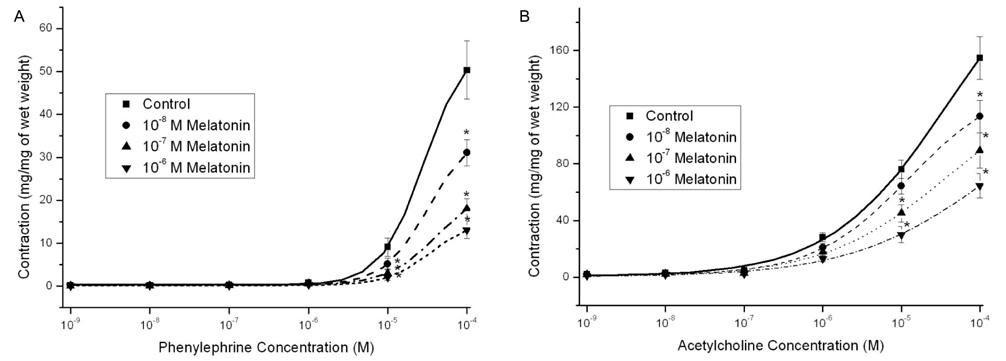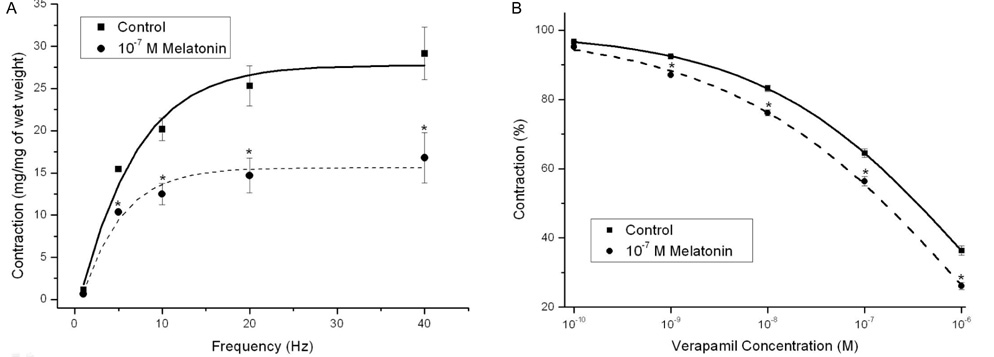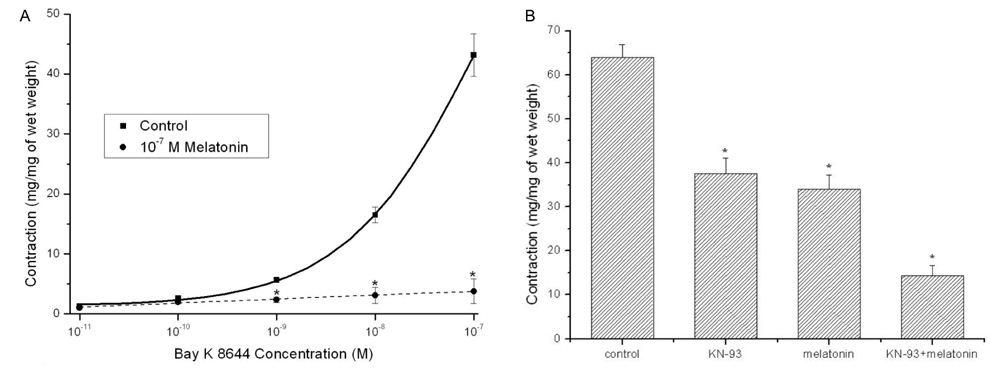Korean J Physiol Pharmacol.
2012 Feb;16(1):37-42. 10.4196/kjpp.2012.16.1.37.
A Novel Pathway Underlying the Inhibitory Effects of Melatonin on Isolated Rat Urinary Bladder Contraction
- Affiliations
-
- 1Department of Urology, KEPCO Medical Foundation, Han-il General Hospital, Seoul 132-703, Korea.
- 2Department of Urology, Chung-Ang University Hospital, College of Medicine, Chung-Ang University, Seoul 156-755, Korea. kim14141@hananet.net
- 3Department of Physiology, College of Medicine, Chung-Ang University, Seoul 156-755, Korea.
- 4Department of Microbiology, College of Medicine, Chung-Ang University, Seoul 156-755, Korea.
- 5Department of Urology, Kwandong University Myungji Hospital, Goyang 412-270, Korea.
- 6Department of Urology, Seoul Medical Center, Seoul 131-130, Korea.
- 7Department of Urology, Hanyang University Guri Hospital, Guri 471-701, Korea.
- KMID: 2285438
- DOI: http://doi.org/10.4196/kjpp.2012.16.1.37
Abstract
- The aim of the present study was to elucidate the direct effects of melatonin on bladder activity and to determine the mechanisms responsible for the detrusor activity of melatonin in the isolated rat bladder. We evaluated the effects of melatonin on the contractions induced by phenylephrine (PE), acetylcholine (ACh), bethanechol (BCh), KCl, and electrical field stimulation (EFS) in 20 detrusor smooth muscle samples from Sprague-Dawley rats. To determine the mechanisms underlying the inhibitory responses to melatonin, melatonin-pretreated muscle strips were exposed to a calcium channel antagonist (verapamil), three potassium channel blockers [tetraethyl ammonium (TEA), 4-aminopyridine (4-AP), and glibenclamide], a direct voltage-dependent calcium channel opener (Bay K 8644), and a specific calcium/calmodulin-dependent kinase II (CaMKII) inhibitor (KN-93). Melatonin pretreatment (10(-8)~10(-6) M) decreased the contractile responses induced by PE (10(-9)~10(-4) M) and Ach (10(-9)~10(-4) M) in a dose-dependent manner. Melatonin (10(-7) M) also blocked contraction induced by high KCl ([KCl]ECF; 35 mM, 70 mM, 105 mM, and 140 mM) and EFS. Melatonin (10(-7) M) potentiated the relaxation response of the strips by verapamil, but other potassium channel blockers did not change melatonin activity. Melatonin pretreatment significantly decreased contractile responses induced by Bay K 8644 (10(-11)~10(-7) M). KN-93 enhanced melatonin-induced relaxation. The present results suggest that melatonin can inhibit bladder smooth muscle contraction through a voltage-dependent, calcium-antagonistic mechanism and through the inhibition of the calmodulin/CaMKII system.
Keyword
MeSH Terms
-
3-Pyridinecarboxylic acid, 1,4-dihydro-2,6-dimethyl-5-nitro-4-(2-(trifluoromethyl)phenyl)-, Methyl ester
4-Aminopyridine
Acetylcholine
Animals
Benzylamines
Bethanechol
Calcium Channels
Contracts
Melatonin
Muscle, Smooth
Muscles
Nocturia
Phenylephrine
Phosphotransferases
Potassium Channel Blockers
Quaternary Ammonium Compounds
Rats
Rats, Sprague-Dawley
Relaxation
Sulfonamides
Urinary Bladder
Urinary Bladder, Overactive
Verapamil
3-Pyridinecarboxylic acid, 1,4-dihydro-2,6-dimethyl-5-nitro-4-(2-(trifluoromethyl)phenyl)-, Methyl ester
4-Aminopyridine
Acetylcholine
Benzylamines
Bethanechol
Calcium Channels
Melatonin
Phenylephrine
Phosphotransferases
Potassium Channel Blockers
Quaternary Ammonium Compounds
Sulfonamides
Verapamil
Figure
Cited by 2 articles
-
Therapeutic Effects of Prolonged Release Melatonin (Circadin®) in Patients with Overactive Bladder and Chronic Insomnia in More Than 55 Years Old
Min Jung Park, Seon Young Seo, Hyun Jun Park, Jih Hoon Park, Mi Young Lim, Nam Cheol Park
Kosin Med J. 2020;35(2):101-113. doi: 10.7180/kmj.2020.35.2.101.Characteristics of Diprophylline-Induced Bidirectional Modulation on Rat Jejunal Contractility
Fang-Fei Liu, Da-Peng Chen, Yong-Jian Xiong, Bo-Chao Lv, Yuan Lin
Korean J Physiol Pharmacol. 2014;18(1):47-53. doi: 10.4196/kjpp.2014.18.1.47.
Reference
-
1. Abrams P, Cardozo L, Fall M, Griffiths D, Rosier P, Ulmsten U, Van Kerrebroeck P, Victor A, Wein A. Standardisation Sub-Committee of the International Continence Society. The standardisation of terminology in lower urinary tract function: report from the standardisation sub-committee of the International Continence Society. Urology. 2003. 61:37–49.2. Wein A, Lose GR, Fonda D. Nocturia in men, women and the elderly: a practical approach. BJU Int. 2002. 90:Suppl 3. 28–31.3. Homma Y, Yamaguchi T, Kondo Y, Horie S, Takahashi S, Kitamura T. Significance of nocturia in the International Prostate Symptom Score for benign prostatic hyperplasia. J Urol. 2002. 167:172–176.4. Appell RA, Sand PK. Nocturia: etiology, diagnosis, and treatment. Neurourol Urodyn. 2008. 27:34–39.5. Garfinkel D, Laudon M, Nof D, Zisapel N. Improvement of sleep quality in elderly people by controlled-release melatonin. Lancet. 1995. 346:541–544.6. Haimov I, Lavie P, Laudon M, Herer P, Vigder C, Zisapel N. Melatonin replacement therapy of elderly insomniacs. Sleep. 1995. 18:598–603.7. Drake MJ, Mills IW, Noble JG. Melatonin pharmacotherapy for nocturia in men with benign prostatic enlargement. J Urol. 2004. 171:1199–1202.8. Sugaya K, Nishijima S, Miyazato M, Kadekawa K, Ogawa Y. Effects of melatonin and rilmazafone on nocturia in the elderly. J Int Med Res. 2007. 35:685–691.9. Matsuta Y, Yusup A, Tanase K, Ishida H, Akino H, Yokoyama O. Melatonin increases bladder capacity via GABAergic system and decreases urine volume in rats. J Urol. 2010. 184:386–391.10. Semerciöz A, Onur R, Ayar A, Orhan I. The inhibitory role of melatonin on isolated guinea-pig urinary bladder: an endogenous hormone effect. BJU Int. 2004. 94:1373–1376.11. Pandi-Perumal SR, Trakht I, Srinivasan V, Spence DW, Maestroni GJ, Zisapel N, Cardinali DP. Physiological effects of melatonin: role of melatonin receptors and signal transduction pathways. Prog Neurobiol. 2008. 85:335–353.12. Ayar A, Kutlu S, Yilmaz B, Kelestimur H. Melatonin inhibits spontaneous and oxytocin-induced contractions of rat myometrium in vitro. Neuro Endocrinol Lett. 2001. 22:199–207.13. Thor PJ, Krolczyk G, Gil K, Zurowski D, Nowak L. Melatonin and serotonin effects on gastrointestinal motility. J Physiol Pharmacol. 2007. 58:Suppl 6. 97–103.14. Abrams P, Andersson KE. Muscarinic receptor antagonists for overactive bladder. BJU Int. 2007. 100:987–1006.15. Drake MJ. Emerging drugs for treatment of overactive bladder and detrusor overactivity. Expert Opin Emerg Drugs. 2008. 13:431–446.16. Nowak JZ, Zawilska JB. Melatonin and its physiological and therapeutic properties. Pharm World Sci. 1998. 20:18–27.17. Onur R, Ozcan M, Tuygun U, Ozan T, Ayar A, Orhan I. Effects of combined use of trospium chloride and melatonin on in vitro contractility of rat urinary bladder. Urology. 2010. 75:873–877.18. Pressman MR, Figueroa WG, Kendrick-Mohamed J, Greenspon LW, Peterson DD. Nocturia. A rarely recognized symptom of sleep apnea and other occult sleep disorders. Arch Intern Med. 1996. 156:545–550.19. Salvatore S, Soligo M, Proietti F, Citterio S, Artibani W, Milani R. Overactive bladder syndrome: considerations in pharmacotherapy and new perspectives. Eur J Obstet Gynecol Reprod Biol. 2005. 120:129–133.20. Cogé F, Guenin SP, Fery I, Migaud M, Devavry S, Slugocki C, Legros C, Ouvry C, Cohen W, Renault N, Nosjean O, Malpaux B, Delagrange P, Boutin JA. The end of a myth: cloning and characterization of the ovine melatonin MT(2) receptor. Br J Pharmacol. 2009. 158:1248–1262.21. Ouyang H, Vogel HJ. Melatonin and serotonin interactions with calmodulin: NMR, spectroscopic and biochemical studies. Biochim Biophys Acta. 1998. 1383:37–47.22. Ozveren E, Korkmaz B, Buharalioglu CK, Tunctan B. Involvement of calcium/calmodulin-dependent protein kinase II to endotoxin-induced vascular hyporeactivity in rat superior mesenteric artery. Pharmacol Res. 2006. 54:208–218.
- Full Text Links
- Actions
-
Cited
- CITED
-
- Close
- Share
- Similar articles
-
- Effects of Ethanol and its Metabolites on Responses of the Rat Bladder Muscle
- Inhibitory Effects of Tiropramide and Propiverine HCI against Smooth Muscle Contraction of Rat Urinary Bladder: In-vitro Muscle Strip Study
- Effects of Ethanol Oral Administration on Detrusor Muscle and Micturition in the Male Rat
- Inhibitory Effects of Potassium Channel Blockers on Carbachol-induced Contraction in Rat Detrusor Muscle
- Effects of Histamine and Hydroxyzine on the Bladder Contraction of Rat





